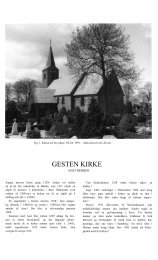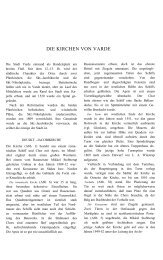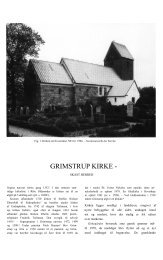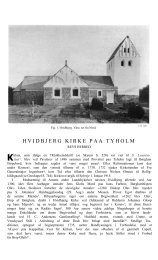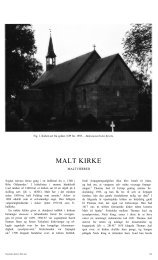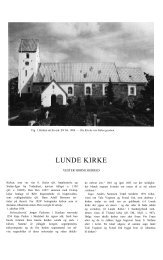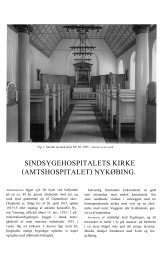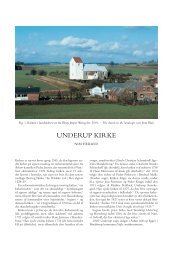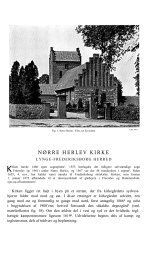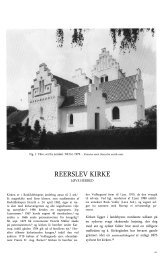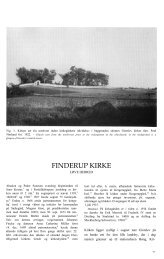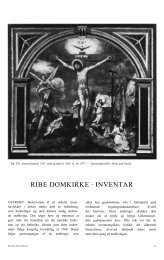SKT. NIKOLAJ KIRKE - Danmarks Kirker - Nationalmuseet
SKT. NIKOLAJ KIRKE - Danmarks Kirker - Nationalmuseet
SKT. NIKOLAJ KIRKE - Danmarks Kirker - Nationalmuseet
Create successful ePaper yourself
Turn your PDF publications into a flip-book with our unique Google optimized e-Paper software.
with paintings (nos. 2, 4, 5), and among other<br />
things stand out with their rare allegorical subjects.<br />
Four others (nos. 6, 7, 8, 9) very unusually<br />
consist of small black stone tablets with an ingeniously<br />
etched calligraphic inscription, signed<br />
on three of them by Villads Pedersen Trellund in<br />
Ribe, 1616. Here as elsewhere in the church, one<br />
gets a sense of the same rich cultural life as flourished<br />
in Renaissance Ribe.<br />
From the second half of the 1600s four carved<br />
sepulchral tablets in an exuberant ‘auricular’ (Ohrmuschel)<br />
style can be mentioned, three of them<br />
a scribed to the Middelfart woodcarver Hans<br />
Bang (no. 11, tablet remains no. 2, and tablet<br />
no. 1 in the Roed and Riis Chapel). Otherwise<br />
the sepulchral tablets from this time were usually<br />
in stone, the most prestigious in varicoloured<br />
marble. The monuments to the bishops Ancher<br />
and Mathias Anchersen should be singled out in<br />
this group; their sepulchral tablets from 1729 and<br />
1770 (nos. 12-13) can be attributed to the best<br />
sculptors in Copenhagen. The former may be the<br />
work of Christian Conrad Gercken; the latter is<br />
certainly by Johannes Wiedewelt.<br />
No fewer than 91 tombstones are known from<br />
the church, 37 of these preserved, and ten that<br />
are only fragments. The remaining 44 are known<br />
partly from transcripts and drawings, partly<br />
from brief mentions in the sources. Of the oldest<br />
tombstones, which go back to the 15th-16th<br />
century, many are aristocratic, including the only<br />
figured stone (no. 2), laid c. 1540 over Hans Johansen<br />
Lindenov of Fovslet, and unique in showing,<br />
under the feet of the deceased, a representation<br />
of a cadaver (a transi). Another aristocratic<br />
figured stone, laid c. 1574 over Morten Svendsen<br />
of ‘Refdal’, has now vanished (†no. 2).<br />
The 17th-century tombstones, mainly those<br />
of burghers, reflect the Renaissance fondness<br />
for cartouche framing and portal structures. A<br />
couple of stones have a special form best known<br />
from North Schleswig/South Jutland and from<br />
the churches in Ribe: an angel inside a portal<br />
holding out a shield-like ‘badge’ or an inscribed<br />
tablet in cartouche (nos. 6, 16 - cf. also no. 15).<br />
Other stones were probably produced locally,<br />
such as a series with characteristic small angels in<br />
ENGLISH SUMMARY<br />
811<br />
the corners, blowing slender trumpets (nos. 12,<br />
15, 16, 17, fragments no. 6 and 7). The tombstones<br />
of clerics are especially recognizable with<br />
their copious inscriptions over the whole width<br />
of the stone (nos. 18, 19, 24).<br />
After the mid-17th century there was a gradual<br />
breakdown of the architectural structure of the<br />
tombstones. Instead decoration took over, first in<br />
the form of auricular ornaments (most clearly in<br />
no. 23) and from c. 1700 in the form of High<br />
Baroque acanthus leaves. Especially popular was<br />
a form with an inscription in large laurel wreaths<br />
surrounded by religious figures and scenes (nos.<br />
20, 22, 25, 27). Among the few stones from the<br />
eighteenth century there are a couple of offshoots<br />
of this tradition (nos. 33, 34).<br />
Like the tombstones, the sepulchral tablets and<br />
a number of military tomb banners refer to burials<br />
in the floor. Some of these could be burials ‘in<br />
earth’, others in low brick chambers, so-called<br />
closed burials, which could be opened through a<br />
hatch or by lifting the tombstone when a new<br />
coffin was to be deposited. An ordinance on<br />
burials from 1601 states that in this area there had<br />
been ‘much impropriety’. This was among other<br />
reasons because in the best places the deceased<br />
were dug up before complete decomposition so<br />
that others could take over the tombs.<br />
The chancel was clearly the burial place for the<br />
clerics, although others could also buy a place<br />
there, for example Mayor Jep Hansen Bøgvad,<br />
who in 1632 paid 50 Dl. for a (closed) burial<br />
in the chancel. The North Chapel, or the ‘New<br />
Church’, belonged to the Castle, which could<br />
grant free burial there. This was typically granted<br />
to the castle officers, who were not rarely of foreign<br />
origin. Thus in 1614 Ulrik Hovri, who had<br />
been born in Switzerland, was granted free burial<br />
there on the orders of the Royal Cupbearer (cf.<br />
also tombstone no. 21). In the ‘New Church’ a<br />
number of Swedish officers were also buried in<br />
1644, but against payment.<br />
Besides the closed burials there were also a<br />
number of ‘open burials’ or sepulchral chapels<br />
with the coffins standing freely on the floor.<br />
The church has preserved two such chapels, the<br />
Been feldt Chapel and the Roed and Riis Chapel,



